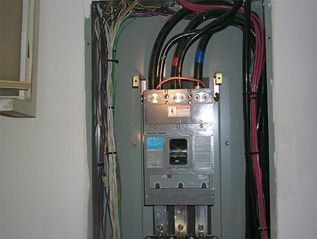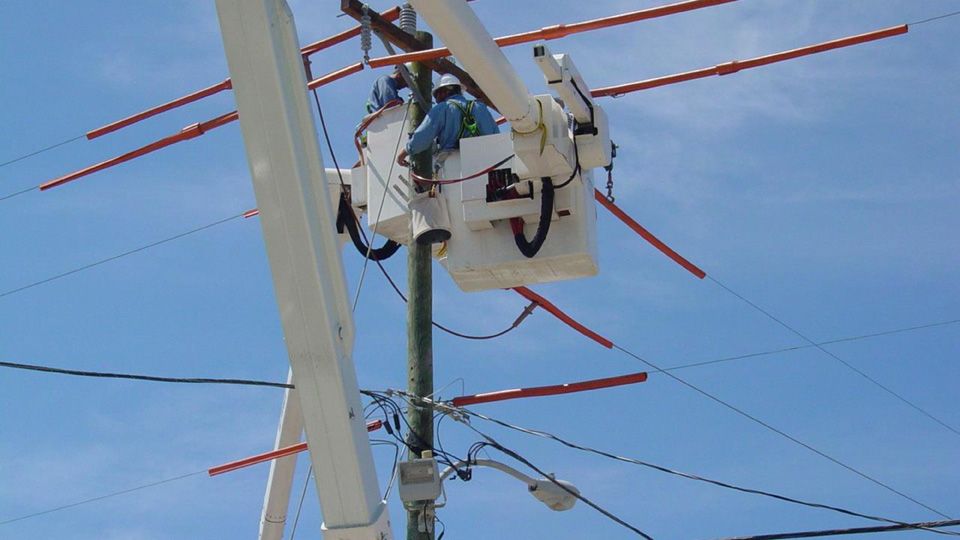Tag: Voice of Experience
Arc Flash Precautions: A Review
Written by Danny Raines, CUSP on . Posted in Voice of Experience.
Ground Gradient Step Potential and PPE
Written by Danny Raines, CUSP on . Posted in Voice of Experience.
The Importance of Proper Coverup: Two Real-Life Tales
Written by Danny Raines, CUSP on . Posted in Voice of Experience.
The End of a Career
Written by Danny Raines, CUSP on . Posted in Voice of Experience.
Installing Fiber-Optic Cable in Electric Supply Spaces
Written by Danny Raines, CUSP on . Posted in Voice of Experience.
System Grounding for Worker Protection Against Induced Voltages
Written by Danny Raines, CUSP on . Posted in Voice of Experience.
Understanding OSHA’s Rules for T&D Equipment Grounding
Written by Danny Raines, CUSP on . Posted in Voice of Experience.
Overhead Line Work, Then and Now
Written by Danny Raines, CUSP on . Posted in Voice of Experience.
System Operations: Who’s in Charge?
Written by Danny Raines, CUSP on . Posted in Voice of Experience.
Sharing My Story: I’m a Male Breast Cancer Survivor
Written by Danny Raines, CUSP on . Posted in Voice of Experience.
Lone Worker Limitations
Written by Danny Raines, CUSP on . Posted in Voice of Experience.
Inspect and Test to Prevent Wood Poles from Falling
Written by Danny Raines, CUSP on . Posted in Voice of Experience.
Is it Maintenance or Construction?
Written by Danny Raines, CUSP on . Posted in Voice of Experience.
Opinion: Looking to the Future During an Unprecedented Time
Written by Danny Raines, CUSP on . Posted in Voice of Experience.
Voice of Experience: The Need for Seasoned Industry Trainers
Written by Danny Raines, CUSP on . Posted in Voice of Experience.
Voice of Experience: Human Performance Failures
Written by Danny Raines, CUSP on . Posted in Voice of Experience.
Voice of Experience: Accurate Utility Locates are Critical to Crew Safety
Written by Danny Raines, CUSP on . Posted in Voice of Experience.
Voice of Experience: The Safe and Proper Use of Bucket Trucks
Written by Danny Raines, CUSP on . Posted in Voice of Experience.
Voice of Experience: Saved by the Bond
Written by Danny Raines, CUSP on . Posted in Voice of Experience.
Voice of Experience: What Do New Employees Need to Know?
Written by Danny Raines, CUSP on . Posted in Voice of Experience.
Voice of Experience: Clearing Up Confusion About OSHA Record-Keeping Requirements
Written by Danny Raines, CUSP on . Posted in Voice of Experience.
Voice of Experience: Planning for a Storm Restoration Effort
Written by Danny Raines, CUSP on . Posted in Voice of Experience.
Voice of Experience: How Was Your 2018?
Written by Danny Raines, CUSP on . Posted in Voice of Experience.
Voice of Experience: Why Do Accidents Keep Happening?
Written by Danny Raines, CUSP on . Posted in Voice of Experience.
Voice of Experience: The Value of Worker Training
Written by Danny Raines, CUSP on . Posted in Safety Management, Voice of Experience.
Voice of Experience: Understanding Induced Voltage
Written by Danny Raines, CUSP on . Posted in Safety Management, Voice of Experience.
Voice of Experience: When Training New Workers, Be Vigilant
Written by Danny Raines, CUSP on . Posted in Voice of Experience.
Voice of Experience: Can Human Error Be a Root Cause?
Written by Danny Raines, CUSP on . Posted in Voice of Experience.
Voice of Experience: Electric Utility Accidents and Injuries: Why Are We Regressing?
Written by Danny Raines, CUSP on . Posted in Voice of Experience.
Voice of Experience: Distribution Cover-Up: Why Wouldn’t You Use It?
Written by Danny Raines, CUSP on . Posted in Safety Management, Voice of Experience.
Voice of Experience: De-Energizing Lines and Equipment for Employee Protection
Written by Danny Raines, CUSP on . Posted in Worksite Safety, Voice of Experience.
Voice of Experience: OSHA Record-Keeping Requirements
Written by Danny Raines, CUSP on . Posted in Safety Management, Voice of Experience.
Voice of Experience: Inspection, Maintenance and Fall Protection Guidance for Bucket Truck Use
Written by Danny Raines, CUSP on . Posted in Safety Management, Worksite Safety, Voice of Experience, Equipment Operations.
Voice of Experience: Switching and Working on UD Systems
Written by Danny Raines, CUSP on . Posted in Safety Management, Worksite Safety, Voice of Experience, Equipment Operations.
Voice of Experience: OSHA’s MAD Changes and a Missed Opportunity
Written by Danny Raines, CUSP on . Posted in Safety Management, Worksite Safety, Voice of Experience.
Voice of Experience: OSHA Requirements for Step Potential Protection
Written by Danny Raines, CUSP on . Posted in Safety Management, Worksite Safety, Voice of Experience.
Voice of Experience: OSHA Citations and Informal Conferences
Written by Danny Raines, CUSP on . Posted in Safety Management, Worksite Safety, Voice of Experience.
Voice of Experience: Hand and Skin Protection for Electric Utility Workers
Written by Danny Raines, CUSP on . Posted in Safety Management, Worksite Safety, Voice of Experience.
Voice of Experience: PPE Regulatory and Consensus Standard Requirements
Written by Danny Raines, CUSP on . Posted in Safety Management, Worksite Safety, Voice of Experience.
Voice of Experience: Clearing Up Confusion About 1910.269
Written by Danny Raines, CUSP on . Posted in Safety Management, Worksite Safety, Voice of Experience.
Voice of Experience: Power Generation Safety and the OSHA Update
Written by Danny Raines, CUSP on . Posted in Safety Management, Worksite Safety, Voice of Experience.
Voice of Experience: Fundamentals of Underground Padmount Transformers
Written by Danny Raines, CUSP on . Posted in Safety Management, Voice of Experience, Equipment Operations, Grounding.
Voice of Experience: OSHA Updates to Arc-Rated FR Clothing Requirements
Written by Danny Raines, CUSP on . Posted in Safety Management, Worksite Safety, Voice of Experience.
Voice of Experience: The Importance of Job Briefings
Written by Danny Raines, CUSP on . Posted in Safety Management, Worksite Safety, Voice of Experience.
Voice of Experience: How Does the Employer Ensure and Demonstrate?
Written by Danny Raines, CUSP on . Posted in Safety Management, Voice of Experience.
Voice of Experience: Flame-Resistant Apparel is Now PPE
Written by Danny Raines, CUSP on . Posted in Safety Management, Worksite Safety, Voice of Experience.
Voice of Experience: OSHA Eye and Face Protection Standards
Written by Danny Raines, CUSP on . Posted in Safety Management, Worksite Safety, Voice of Experience.
Voice of Experience: Understanding Enclosed and Confined Spaces
Written by Danny Raines, CUSP on . Posted in Safety Management, Worksite Safety, Voice of Experience.
Voice of Experience: OSHA 300 Record-Keeping Rules
Written by Danny Raines, CUSP on . Posted in Safety Management, Voice of Experience.
Voice of Experience: Working On or Near Exposed Energized Parts
Written by Danny Raines, CUSP on . Posted in Worksite Safety, Voice of Experience.
Voice of Experience: Incidents and the Failure to Control Work
Written by Danny Raines, CUSP on . Posted in Worksite Safety, Voice of Experience.
Voice of Experience: Training for the Qualified Employee
Written by Danny Raines, CUSP on . Posted in Safety Management, Voice of Experience.
Voice of Experience: The Cost of Business
Written by Danny Raines, CUSP on . Posted in Safety Management, Voice of Experience.
Voice of Experience: The Definition of Personal Protective Equipment
Written by Danny Raines, CUSP on . Posted in Safety Management, Voice of Experience.
Voice of Experience: Are You Ready for the Big Storm?
Written by Danny Raines, CUSP on . Posted in Safety Management, Voice of Experience.
Voice of Experience: FMCSR Compliance: Driver Qualification Files
Written by Danny Raines, CUSP on . Posted in Safety Management, Voice of Experience.
Voice of Experience: Safety Excellence Equals Operational Excellence
Written by Danny Raines, CUSP on . Posted in Leadership Development, Voice of Experience.



